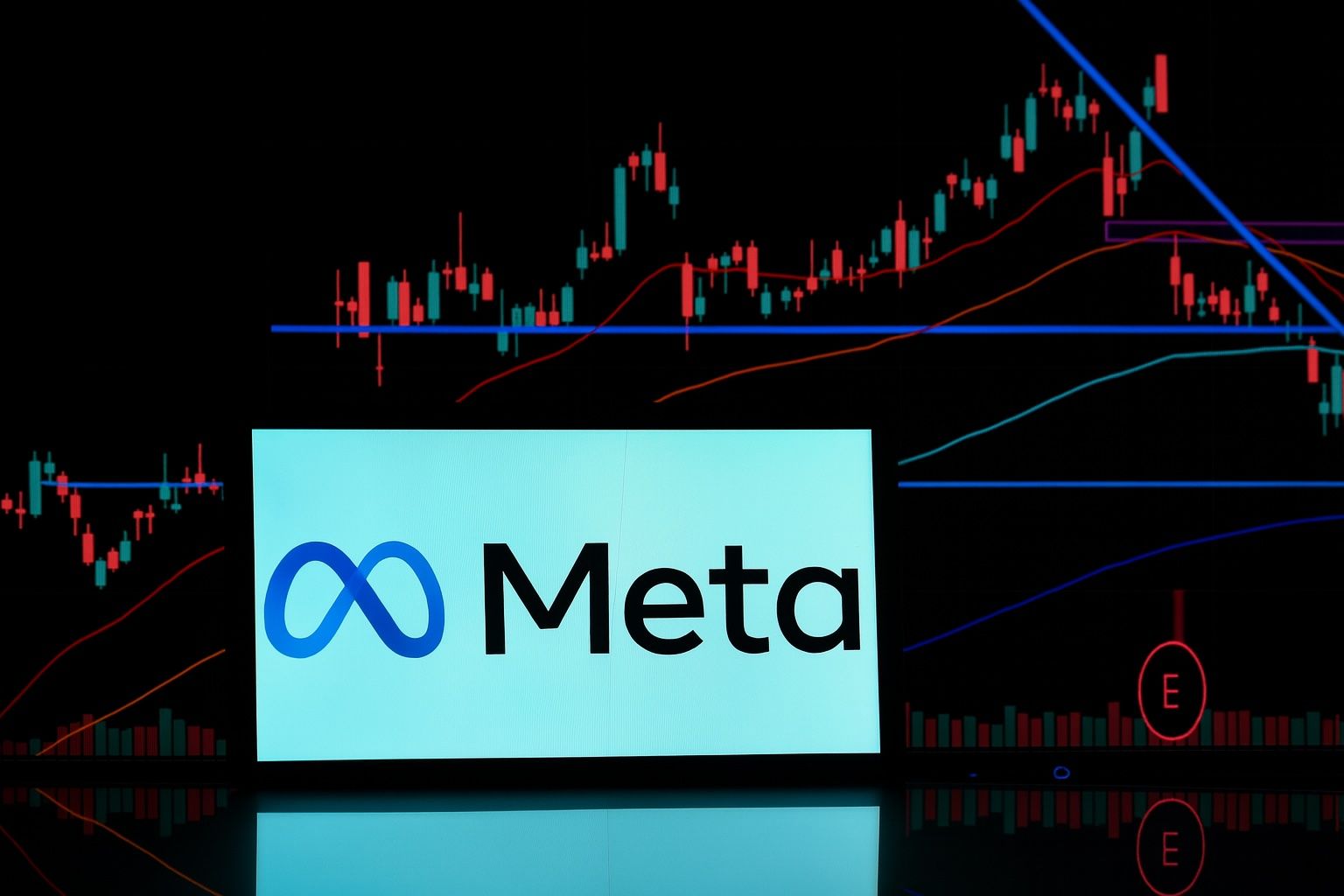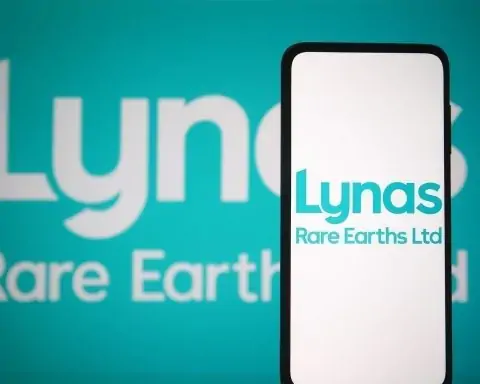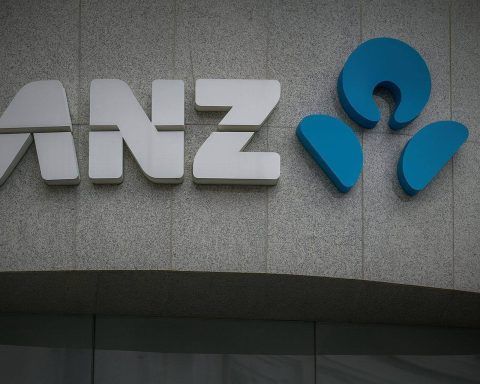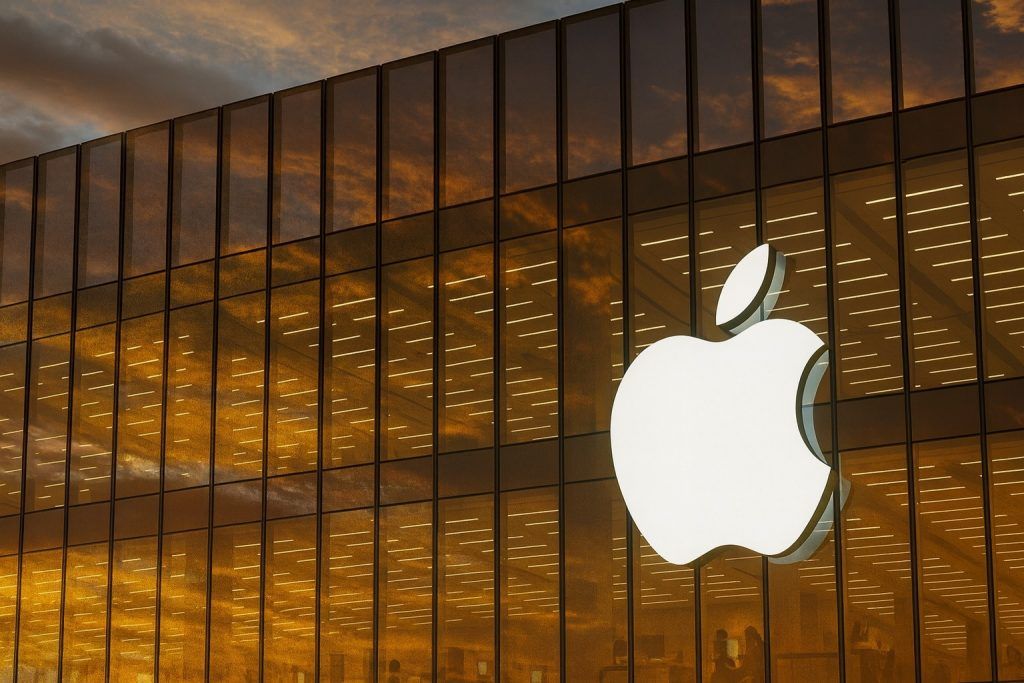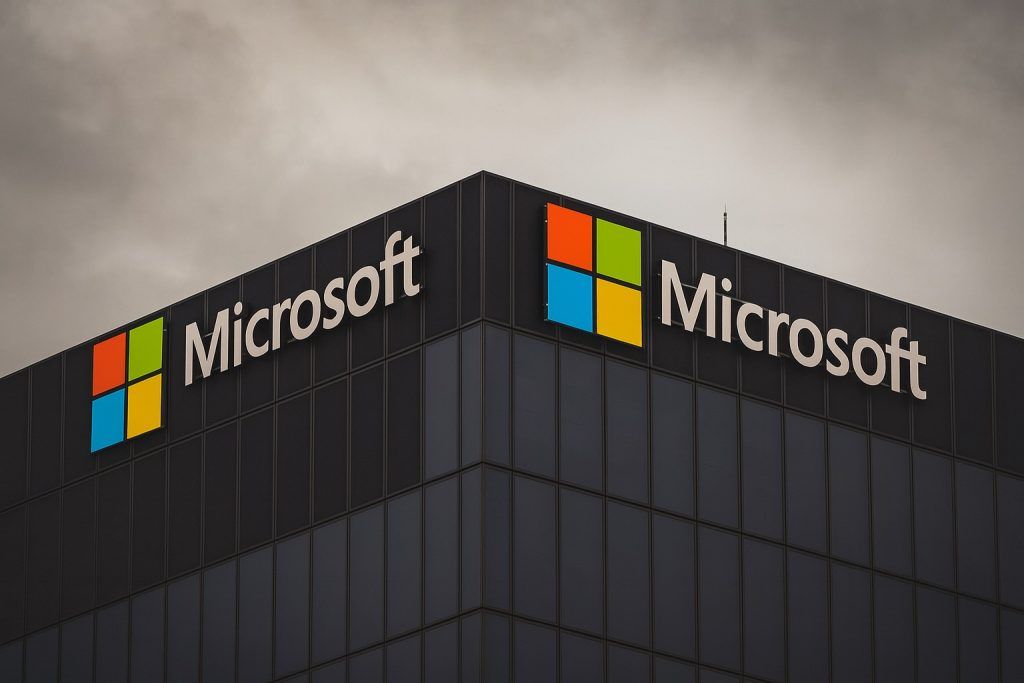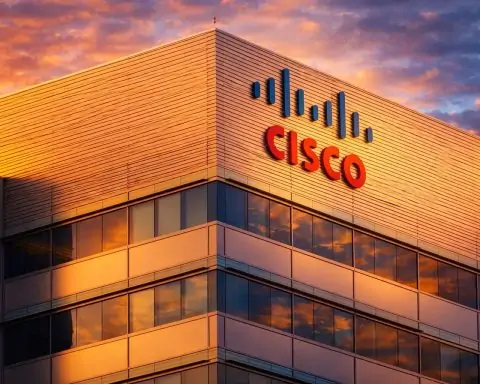Key Facts: Meta shares trade around $730–$740 in late Oct 2025 [1], near all-time highs (≈$789 in August) [2]. The stock is up roughly 25% year-to-date [3], well above the broader market. In Q2 2025 Meta reported $47.52B revenue (+22% YoY) and $18.34B net income [4], beating estimates. Management guided Q3 revenue to $47.5–50.5B (≈+20% YoY) [5] (analysts expect ≈$49.4B [6]). Wall Street is broadly bullish – ~85% of covering analysts rate META a Buy/Strong Buy [7], with 12‑month targets averaging around $825 [8] (some as high as $900+). Major recent developments include a $27–30B Louisiana data-center joint venture (Meta keeps 20% ownership) [9], the announced purchase of AI chipmaker Rivos (~$2B) [10], and aggressive AI talent hires (e.g. a $1.5B package for researcher Andrew Tulloch) [11]. Regulatory pressures are mounting: Meta will suspend paid political ads in the EU from Oct 2025 [12] under new transparency laws, and faces EU probes under the Digital Services/Markets Acts [13]; in the U.S., the FTC’s antitrust suit over Instagram/WhatsApp is still pending [14].
Stock Performance & Recent Moves
Meta’s stock has enjoyed a strong run in 2025. From under $600 in January, it climbed to the mid-$700s by fall [15]. In mid-October the share price hovered around $730–$735 [16], a level few percent below its August peak. Over the past 10 trading days the stock has closed higher on 7 days [17], though it has eased off its highs as some profit-taking kicked in. For example, the Oct 22 close was $733.41 [18], up modestly from $724 the prior day, with a trading range about $724–$741 [19]. Technical indicators suggest a near-term consolidation: one analysis notes support around ~$717 and resistance near ~$741 [20]. Overall Meta’s 25% YTD gain [21] has outpaced many peers (Alphabet/Google is up ~48% in six months, Apple ~12% [22]), reflecting optimism in tech and AI.
Earnings & Financial Trends
Meta’s fundamentals remain solid. In Q2 2025 (ended June 30) the company reported $47.52 billion in revenue (up 22% YoY) and $18.34 billion in net income [23]. Earnings per share were $7.14, well above consensus. Advertising strength drove the beat: AI-powered ad tools lifted conversion rates (about +5% on Instagram ads [24]) and ad engagement rebounded. Notably, short-video Reels is a key growth engine – eMarketer projects Reels will account for over half of Meta’s U.S. ad revenue this year [25]. Meta also expects brisk growth ahead: management guided Q3 revenue to $47.5–50.5B [26], in line with analysts’ ~21% YoY growth forecast [27]. CEO Zuckerberg is plowing profits into future growth: Meta raised its 2025 capital-expenditure plan to $66–72B [28] (up from previous plans), financing massive AI data centers and R&D. Importantly, Meta still generates huge cash flow: it had ~$25.6B operating cash in Q2 and has returned nearly $10B to shareholders via buybacks/dividends [29], underscoring its profitability even amid big investments.
AI & Infrastructure Push
A focal point for Meta – and a driver of its stock – is its massive investment in AI. In mid-October Bloomberg reported Meta is finalizing an almost $30 billion private financing deal for its new “Hyperion” AI data-center in rural Louisiana [30]. Under the deal, Blue Owl Capital and other investors fund most of the build (over $27B in debt and ~$2.5B equity), while Meta retains only 20% ownership [31]. The Hyperion campus will span ~4 million sq. ft. with ~5 GW of power (enough to power ~4M homes), making it one of the world’s largest data facilities [32]. Meta is also expanding elsewhere – e.g. a $1.5B AI data center in El Paso, Texas, to add 1 GW capacity [33] – and boosting its AI cloud via new partnerships (Reuters notes $14B CoreWeave deal and $10B Google Cloud deal this year [34]). CEO Zuckerberg says AI breakthroughs will justify the spending. Indeed, analysts credit AI for Meta’s current momentum: improved recommendation systems drove ad impressions +11% and price per ad +9% in Q2 [35], helping the core business surge while Meta invests for the future.
Meta isn’t just building machines – it’s buying talent. It scooped up AI researchers with eye-popping packages: for example, co-founder of AI startup Thinking Machines (Andrew Tulloch) reportedly got a $1.5 billion compensation deal to join Meta [36]. Last quarter Meta spent $14.3B for a 49% stake in AI unicorn Scale AI, bringing its CEO Alexandr Wang into Meta’s fold [37]. The company also agreed to acquire chip designer Rivos (a RISC-V AI chip startup) for about $2B, to speed up its custom AI processors [38]. As one tech analyst put it, “Mark Zuckerberg isn’t done with nabbing big-name AI talent.” [39] These moves underscore Meta’s all-in bet on AI – and help explain why investors have bid the stock so high, betting that today’s expense spree will seed tomorrow’s leadership.
Metaverse & New Products
Meta’s push into augmented and virtual reality also grabbed headlines. The company dominates the XR hardware market – roughly 60% of AR/VR device shipments in Q2 were Meta’s Quest headsets or Ray-Ban smart glasses [40]. In late September at its Connect event, Meta unveiled the Ray-Ban Meta “Display” smart glasses ($799) equipped with an AR display [41]. Early demos on stage encountered glitches [42], but the underlying market signal is positive: Meta’s collaboration with EssilorLuxottica (Ray-Ban’s owner) is already paying off. EssilorLuxottica reported an 11.7% jump in Q3 sales attributed largely to demand for Ray-Ban Meta glasses [43] – its best quarter ever – and the stock spiked nearly 14% on the news [44] [45]. Analysts are optimistic about wearable AR: Barclays forecasts ~60 million smart glasses sold by 2035, making it “the most disruptive innovation since smartphones” [46]. Meanwhile, Meta’s VR strategy appears stronger than Apple’s: reports suggest Apple has paused its $3,500 Vision Pro headset in favor of cheaper AR devices [47], validating Meta’s focus on mass-market hardware. (Meta’s Reality Labs unit still loses money – it lost about $3.7B in Q2 [48] – but early consumer interest in its devices is a hopeful sign.)
Analyst Forecasts & Commentary
Wall Street remains broadly bullish on META. According to data tracker MarketBeat, about 40–45 analysts cover the stock and roughly 85% give it a Buy/Strong-Buy rating [49]. The average 12-month price target is in the mid-$800s [50], implying ~10–15% upside. Major brokerages have recently raised targets: Piper Sandler to $880, JPMorgan to $875 [51], Mizuho and Cantor Fitzgerald ~ $920–925, and Bank of America at $900 [52]. Even Forbes has noted the “bull run” could carry META above $800 [53]. Some bullish forecasts see the stock near $875 by year-end if growth continues [54]. These targets reflect confidence in Meta’s advertising rebound and AI edge – at ~$1.8T market cap, Meta still trades around 25–26× forward earnings (roughly on par with Google and cheaper than Apple [55] [56]), which many analysts view as reasonable given 20%+ revenue growth and 40%+ profit margins.
But experts also offer caution. Emarketer analyst Minda Smiley observes that “AI-driven investments into Meta’s advertising business continue to pay off … but Meta’s exorbitant spending on its AI visions will continue to draw questions.” [57] In other words, investors are fine with heavy capex for now as long as core profits hold up. Meta’s Q3 report (due Oct 29) will be a key test: can it keep delivering blowout revenue growth while justifying its outlays? Wall Street will scrutinize ad demand, especially given any macro or privacy headwinds.
Competition and Regulatory Outlook
Meta operates in fiercely competitive markets. In social media, ByteDance’s TikTok remains a top rival for user attention – Meta CEO Zuckerberg has admitted missing the TikTok trend early [58]. Snap and Google’s YouTube Shorts are also vying for ad dollars, especially in short-form video [59]. In AI, Meta’s open-source Llama models face off against Google’s Gemini and OpenAI’s new offerings [60]. In XR, Meta leads for now, but Apple and others could return. (Indeed, recent reports say Apple’s AR/VR roadmap has shifted toward cheaper devices, which could still spark a fresh round of competition [61].)
Regulatory and political pressures are mounting too. In the EU, Meta announced it will ban political, election and social-issue ads on Facebook/Instagram in the EU starting October 2025 [62], following Google’s similar move. This decision was made in response to the EU’s new Transparency and Targeting of Political Advertising rules – companies must label all political ads or face huge fines [63]. Meta warned the rules create “significant legal uncertainties,” but it chose to avoid penalties by suspending such ads [64] [65]. The EU is also cracking down on Meta under its Digital Services Act and Digital Markets Act: for example, a Dutch court recently ordered Meta to offer a chronological (non-algorithmic) feed [66], and the DMA will eventually restrict some targeted-advertising practices. In the U.S., the Federal Trade Commission’s antitrust case to unwind Instagram/WhatsApp is still unresolved [67] – the judge heard arguments in April, with a ruling expected late 2025. All this means Meta must navigate a tougher legal landscape that could trim future growth or force business changes.
Meta’s investors will keep a close eye on these factors. With the stock near its highs, some analysts note there may be limited upside left – yet many see the company’s AI-driven momentum supporting more gains. As Forbes put it, Meta’s combination of high growth, strong profit margins, and modest valuation “seems likely to bring it over the $800 mark” [68]. Next catalysts include the Oct. 29 earnings print and any global ad-market trends. If Meta can deliver another strong quarter, the stock could push toward the mid-$800s or beyond; but if advertising demand falters or regulators bite deeper, the rally may pause. For now, Meta’s “all-in” strategy on AI and immersive tech is the story investors are betting on – and the market’s reaction suggests they’re willing to give it the benefit of the doubt [69] [70].
Sources: Company reports and analyst research (TechStock²/ts2.tech, Reuters, Bloomberg, MarketBeat, etc.) [71] [72] [73] [74] [75] [76] [77].
References
1. stockinvest.us, 2. ts2.tech, 3. ts2.tech, 4. ts2.tech, 5. ts2.tech, 6. www.ig.com, 7. ts2.tech, 8. ts2.tech, 9. www.bloomberg.com, 10. ts2.tech, 11. ts2.tech, 12. www.reuters.com, 13. ts2.tech, 14. www.reuters.com, 15. ts2.tech, 16. stockinvest.us, 17. stockinvest.us, 18. stockinvest.us, 19. stockinvest.us, 20. stockinvest.us, 21. ts2.tech, 22. ts2.tech, 23. ts2.tech, 24. www.reuters.com, 25. www.reuters.com, 26. ts2.tech, 27. www.ig.com, 28. www.reuters.com, 29. ts2.tech, 30. www.bloomberg.com, 31. www.bloomberg.com, 32. ts2.tech, 33. ts2.tech, 34. ts2.tech, 35. ts2.tech, 36. ts2.tech, 37. ts2.tech, 38. ts2.tech, 39. ts2.tech, 40. ts2.tech, 41. ts2.tech, 42. ts2.tech, 43. ts2.tech, 44. ts2.tech, 45. ts2.tech, 46. ts2.tech, 47. ts2.tech, 48. ts2.tech, 49. ts2.tech, 50. ts2.tech, 51. www.marketbeat.com, 52. ts2.tech, 53. ts2.tech, 54. ts2.tech, 55. ts2.tech, 56. ts2.tech, 57. www.reuters.com, 58. www.reuters.com, 59. ts2.tech, 60. ts2.tech, 61. ts2.tech, 62. www.reuters.com, 63. www.reuters.com, 64. www.reuters.com, 65. www.reuters.com, 66. ts2.tech, 67. www.reuters.com, 68. ts2.tech, 69. www.reuters.com, 70. ts2.tech, 71. ts2.tech, 72. www.bloomberg.com, 73. ts2.tech, 74. www.reuters.com, 75. www.reuters.com, 76. ts2.tech, 77. ts2.tech
